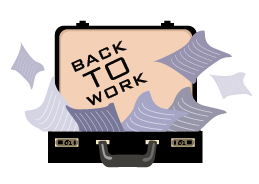
Alan Rosenspan's
Improve Your Response Newsletter
 *** 61st "Back to Work" Edition *** *** 61st "Back to Work" Edition ***
1.We Have a Blog
2. Price Check
3. 99 Marketing Ideas
4. Fulfillment is Everything
5. Google Analytics
6. Focus on Focus Groups
7. Don't Make Me Think
Dear Friends,
I hope you were able to enjoy the summer . . .
As I am writing this, The Chairman of the Federal Reserve Board announced that he thinks the recession may be over.
I don't share his optimism, but as Winston Churchill said at a turning point in World War II: "This is not the end. This is not the beginning of the end. But this may well be the end of the beginning."
So hopefully, the next few months will see an upswing in the economy, and I hope, an upswing in your business as well.
All the best, Alan
We Have a Blog
 I finally succumbed to the siren song of social marketing – and I have a blog. I've always been late to the party . . . I finally succumbed to the siren song of social marketing – and I have a blog. I've always been late to the party . . .
The reason I started it is that I wanted to share my thinking on a more timely basis than my newsletter, and occasionally write a shorter piece.
I've probably violated all the best practices of blogging, so if you are experienced in this area, I would love to get your feedback. You can access it through my website or at http://improveresponse.blogspot.com
My most recent post was an article on how you can recognize good copy - and good copywriters.
top of page
Price Check
I've been a long-term subscriber to Marcia Yudkin's e-newsletter, The Marketing Minute, which I highly recommend.
Marcia sends out nuggets of useful information once a week for the past 10 years. A recent one focused on how to price your product and it had some fascinating insights.
Marcia wrote:
"A price is a price, right? Not really, according to Cornell University researchers, who tested whether restaurant owners would profit most when menu prices were formatted as $20.00, 20.00 or twenty dollars.
To their surprise, the 20.00 format netted the most, with customers spending 8 percent more when menus used numerals to represent prices, minus any dollar signs.
Without the dollar sign or the word "dollars," diners were apparently reminded least that what they were ordering was making them a tiny bit poorer.
Specialists in the field of "menu engineering" have also discovered that menus bring in more revenue when they insert prices at the end of each small paragraph describing the item, rather than all lined up in a column that can be quickly scanned from top to bottom.
Likewise, those who study these things tell us that we tend to perceive $23 to be less than $23.00.
One more finding: When looking at menus, we take prices like $20.00 as indicative of higher quality food than prices like $19.99."
You can subscribe to her newsletter free at http://www.yudkin.com/markmin.htm
top of page
99 Marketing Ideas
 As long as I am recommending other resources, my friend Grant Johnson of Johnson Direct published a booklet that no direct marketer should be without. As long as I am recommending other resources, my friend Grant Johnson of Johnson Direct published a booklet that no direct marketer should be without.
It's called 99 Bright Measurable Marketing Ideas and it's available free at www.johnsondirect.com
Besides the ideas about direct marketing, Grant includes eight key ideas for people.
My favorite is "99. Develop a clear core marketing message about yourself. Help your potential customers to understand what you do. It will help you persuade them to do business with you and can lead to other professionals referring prospects to you."
By the way, this idea also applies to job hunting. You need to immediately position yourself so your potential employer understands:
- Who you are
- What you can do best
- What makes you unique
- Why you would be of value to the company
Grant also has a free newsletter, which you can subscribe to on his website.
(Please note: I'm not trying to steer you away from my newsletter, or over-burden you with information, I'm just trying to be helpful)
top of page
Fulfillment is Everything
Hallie Mummert, Editor-in-Chief of Target Marketing magazine just asked me to do a webinar on fulfillment.
Just to be clear, fulfillment is what you send to prospects after they hold up their hand.
The reason I agreed to do it is because many direct marketers spend so much time and money generating leads, and then treat fulfillment like a poor cousin.
But fulfillment is much, much more important than that – for a number of different reasons.
1. Fulfillment only goes to interested and presumably qualified prospects. That means you can spend more on them; give them more information; and treat them differently than you would a general prospect.
2. Fulfillment can be customized. You may be mailing or e-mailing a broad list of businesses or consumers.
However, once they hold up their hands to request more information, you have the opportunity to (A) ask them questions that will help you decide what to send, and (B) version your fulfillment according to their industry, their interests, or any other variable.
So for example, if a financial services company requests information from me, I can send them my financial services samples. But if a travel company requests information from me, then they would get a very different fulfillment package.
3. Finally, fulfillment defines your company. If I request a catalog from you, and I only receive it three weeks later, I'll have to conclude that's how you do business.
And anything I order from you will take the same amount of time.
However, if I receive your catalog three days later, then (A) I will be very impressed, and (B) I will still be in an "interested, buying" mode.
Fast fulfillment is so important that if operational issues prevent you from doing it quickly – I recommend calling or e-mailing the customer to let them know that "we have your request and we are putting it together for you now."
My webinar also focuses on the mistakes some companies make with fulfillment, the most important of which is this:
Fulfillment is not the last step of your marketing program – it's simply the next step.
That means you need to create a fulfillment package that includes an offer, and a reason for the person to take the next step in the buying process.
By the way, fulfillment can also be used after someone has actually ordered your product. I recently made a purchase from Better World Books and received a charming follow-up e-mail:
Hey Alan,
We're just checking in to see if you received your order (How to Keep Your Husband Alive: An Empowerment Tool for Women Who Care About Their Man's Health) from Better World Books. If your order hasn't blessed your mailbox just yet, heads are gonna roll in the Mishawaka warehouse! Seriously though, if you haven't received your order or are less than 108.8% satisfied, please reply to this message. Let us know what we can do to flabbergast you with service.
Sincerely,
Better World Books Customer Care
Their only mistake? They could have suggested another book on the same topic, or from the same author.
top of page
Google Analytics
If you haven't heard about this service – or taken advantage of it – you're missing a major opportunity.
Google Analytics is a free web analytics solution that gives you insights into your website traffic and marketing effectiveness.
The service is free and easy-to-use. All you have to do is register at www.google.com/analytics and then install it on your site. (I had my web designer do this, and it was fast and inexpensive.)
What you can then do is access a daily report – with data going back a month – that shows you all of the following:
- How many web visitors you had
- How many were new visitors
- How long did they stay on your site
- What they looked at
- Where they came from – search engines, direct traffic or referring sites
Again, all of this is absolutely free. But you can also pay for custom reports and access a deeper level of information.
Google claims this information will make you "more prepared to write better-targeted ads, strengthen your marketing initiatives and create higher converting websites."
I changed the home page of my website based on what I learned – and focused it more on my core business of improving results.
Google has more sophisticated web analysis tools, but this is the place to start.
top of page
Focus on Focus Groups
John Mitchell has sold more reverse mortgages than anyone in his home state of Texas – and quite possibly the entire country.
He's the expert – but he's smart enough to know what he doesn't know. So John is holding a number of focus groups in the fall and asked for my advice on how to structure them.
As you may know, focus groups are where you hire 8-10 people, put them in a conference room behind a two-way mirror, and ask them questions about your product, your marketing materials, or any new ideas.
General advertisers have used them for years, and they almost always provide valuable input. They are especially important for launching new products (or deciding not to launch them, based on the reaction!)
On the other hand, few direct marketers use focus groups, because they only measure what people say they will do, instead of what they actually do.
So they prefer to do their research by actually testing via e-mail or mail.
The thing they miss is the added value of having consumers talk about their products or services, and maybe even come up with new ideas or approaches.
I've attended or conducted over 100 focus groups and I've learned the best ways to structure them, mistakes to avoid, what should be included.
If you are interested, please e-mail me at ARosenspan@aol.com and I'll be happy to share what we know.
top of page
Don't Make Me Think
Steve Krug has sold over 100,000 copies of his amazing book, Don't Make Me Think. A Common Sense Approach to Web Usability.
If you don't have a copy - don't think. Just get one (used from Amazon.com) as soon as possible.
The book is packed with useful, practical, specific ways to make your web site easier for people to understand and navigate.
Many websites have people wondering:
- Where should I start?
- Why did they call it that?
- Can I click on that?
- Why did they put that there?
- Those two links look like the same thing?
- Are they really?
And your job, asserts Steve, is to get rid of all the question marks.
Krug also writes with style and humor, and you'll find yourself enjoying the book as much as using it. And his central philosophy – don't make it hard for people – applies to every media you use.
top of page
Opt out, Opt in, Opportunity
1. Please feel free to forward this newsletter on to a friend or business associate. I'd appreciate it.
2. You can access all our back–issues on our website at www.alanrosenspan.com
3. To unsubscribe, just send me an e–mail that says, "Remove."
Please let me remind you that your name and/or e–mail address will never be shared, sold, circulated, or passed along to anyone else.
Back to Top of Page
| Back to First Page of Newsletters Section

© Alan Rosenspan & Associates
5 Post Office Square
Sharon, MA 02067
Phone: 781-784-8283
e-mail: ARosenspan@aol.com
|